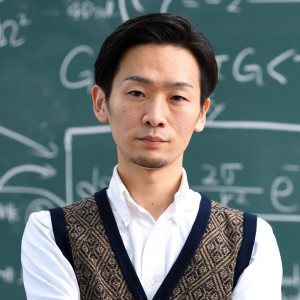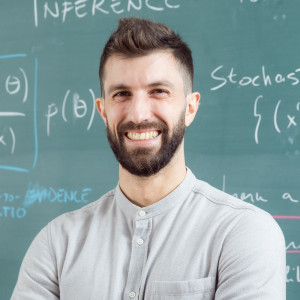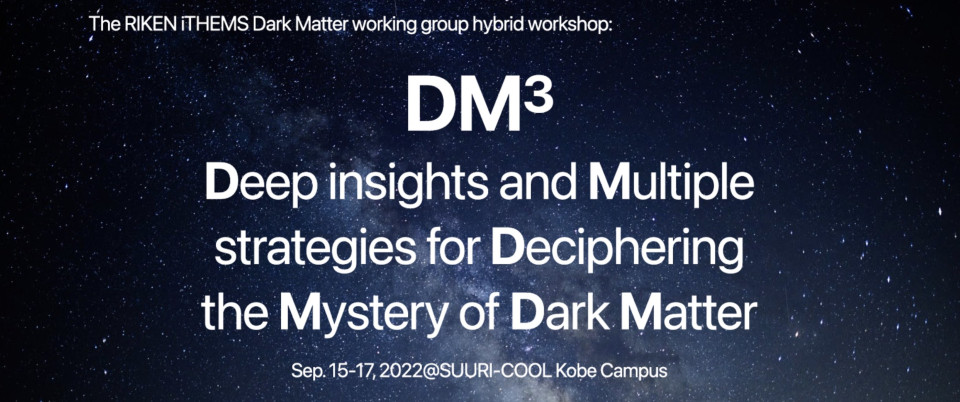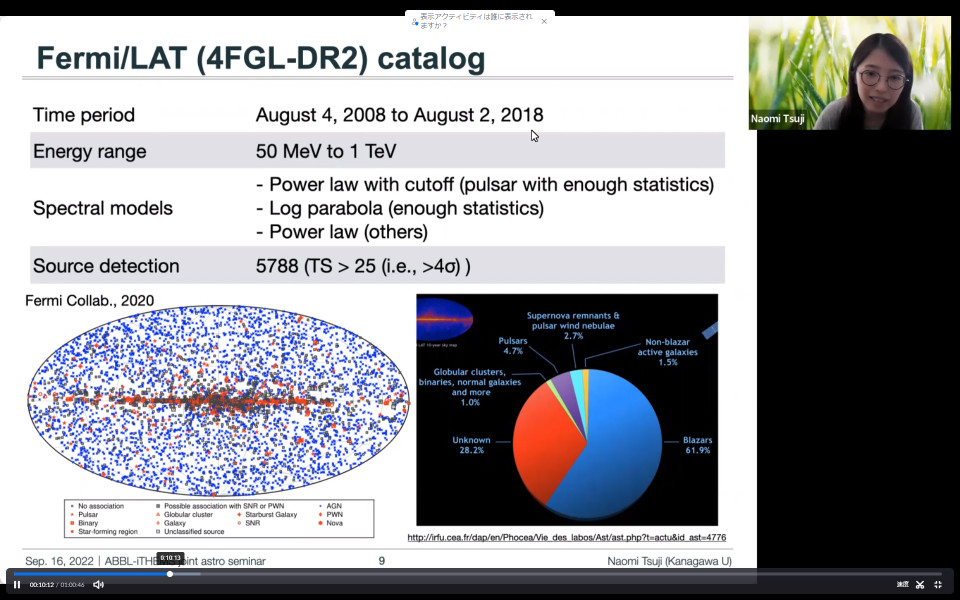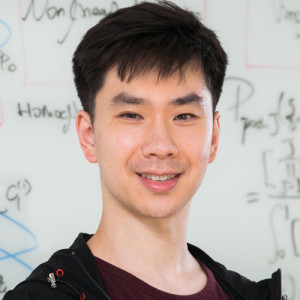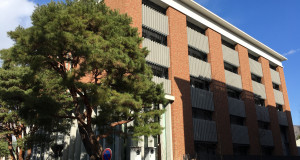Volume 217
Back to Newsletter List
Announcement
Dr. Yuki Yokokura and Dr. Enrico Rinaldi will appear in the NHK TV program Cosmic Front
2022-09-20
Our iTHEMS colleague, Dr. Yuki Yokokura and Dr. Enrico Rinaldi, will appear in the NHK TV program Cosmic Front "Relativity vs. quantum theory: the event horizon and the dance of different dimensions"
Do not miss it !
First broadcast date: September 22, 2022 at 10:00 p.m.
Seminar Report
Report of DM3 Workshop on September 15-17, 2022
2022-09-21
Please enter the seminar report here!The study of dark matter (DM) has a long history. It starts in the 1930s from the article that Zwicky pointed out the existence of a huge invisible mass in galaxy clusters. We now know that about a quarter of the total energy density of the Universe is occupied by DM. But we still do not understand its nature, even we do not know whether or not it is a particle.
We have three kinds of strategies to probe DM so-called collider, direct detection, and indirect detection experiments. By establishing a smooth connection between each other with theoretical support, we should approach a better understanding of DM. With this rationale, the iTHEMS DM working group held an international workshop "DM3- Deep insights and Multiple strategies for Deciphering the Mystery of Dark Matter" during Sep.15-17. The theme of the workshop can be summarized as just a simple question, "what is DM for you?"
The workshop was composed of 18 invited talks for reviews of various DM studies and a poster session for individual presentations. The 1st day has been devoted to the discussion about DM search with astrophysical objects. On the 2nd day, we paid much attention to the particle nature of DM. Novel ideas for candidates and techniques to probe a huge parameter space of DM are exhibited. We went through the intersection between cosmic-ray study and DM search on the final day of the workshop. The latest status of the DM study was presented in posters.
Throughout the workshop, attendees discussed the nature and probe for DM regarding multiple aspects. According to the follow-up questionnaire, they said that "there are differences between the view before and after the workshop" and "would like to continue studying DM".
After the workshop, we reconsider the question again: "what is DM for you?"
There have been so many answers to the question till now. Continuing the study of DM, we believe that we see a consensus someday.
Reported by Nagisa Hiroshima
DM3 - Deep insights and Multiple strategies for Deciphering the Mystery of Dark Matter
September 15 (Thu) - 17 (Sat) 2022
Seminar Report
ABBL-iTHEMS Joint Astro Seminar by Dr. Naomi Tsuji on September 16, 2022
2022-09-16
The MeV gamma-ray domain is the only unexplored window among recent multiwavelength observations in astrophysics, often referred to as the "MeV gap". To fulfill this gap, there are several ongoing and planned projects of MeV gamma-ray telescopes. The measurement of MeV gamma rays (both continuum and line emission) would give us new insight into many topics in astrophysics, such as relativistic jets, particle acceleration, and origin of matter. In advance of the future MeV gamma-ray missions, we have been working on prediction of the MeV gamma-ray sky, which is helpful to determine what kinds of sources can be detectable with the future telescopes. In order to explore the MeV gamma-ray sources, Tsuji-san and her collaborators performed a catalog cross-matching between the hard X-ray (Swift/BAT) and GeV gamma-ray (Fermi/LAT) catalogs, resulting in 145 firmly cross-matched sources. Combined with the Galactic diffuse emission, which is calculated by GALPROP to reconcile the cosmic-ray and gamma-ray spectra with observations by AMS-02, Voyager, and Fermi-LAT, the all-sky maps in the MeV gamma-ray band can be produced. This is also used to investigate a long-standing problem in the MeV gamma-ray astrophysics: the origin of the diffuse emission from the inner Galaxy, measured by COMPTEL. Tsuji-san reported the analysis and results in detail, and introduce future missions of the MeV gamma-ray detectors. There were useful discussions among the speaker and audience during/after the talk.
Reported by Shigehiro Nagataki
MeV gamma-ray all sky simulation
September 16 (Fri) 14:00 - 15:00, 2022
Upcoming Events
Seminar
ABBL-iTHEMS Joint Astro Seminar
Hyperons in neutron stars: fast cooling, Joule heating and hyperon superfluidity
September 26 (Mon) 14:00 - 15:00, 2022
Filippo Anzuini (Postdoc Fellow, Department of Astronomy, Monash University, Australia)
Neutron stars challenge current models of highly dense matter. Despite be- ing the targets of numerous observational campaigns (e.g. gravitational-wave searches and X-ray observations), their equation of state is still unknown. One of the most exciting possibilities is that “unconventional” particles such as hy- perons may appear in neutron star cores. Hyperons have a major impact on the observed thermal luminosity, because they accelerate the cooling rate via direct Urca processes, which copiously increase the neutrino emission from the core. Such mechanism is often considered to be a key signature of hyperon concentrations at high densities. Hyperon superfluidity plays a major role as well, because it can suppress the neutrino emissivity exponentially. The hope is that a comparison of the theoretical cooling curves against the available data of thermally-emitting neutron star can hint towards the existence of hyperons and their superfluidity. There is one ingredient, however, that is often neglected in neutron star cooling models: internal heating. The magnetic field of neutron stars decays due to the dissipation of the electric currents circulating in the crust, generating substantial Joule heating in the shallower layers. The ther- mal power generated by this process can counterbalance hyperon fast cooling, making it difficult to infer the presence of hyperons from the available thermal luminosity data, and complicating the link between measured thermal emission and internal composition. We show that this is the case for magnetars, because their crustal temperature is almost independent of hyperon direct Urca cooling in the core, regardless of whether hyperons are superfluid or not. Likewise, ther- mal luminosity data of moderately magnetized neutron stars are not suitable to extract information about the internal composition, as long as hyperons are superfluid.
Venue: Hybrid Format (Common Room 246-248 and Zoom)
Event Official Language: English
Seminar
iTHEMS Biology Seminar
Discrete Stochastic Model for the Co-infection Dynamics with Defective Interfering Particles
September 26 (Mon) 16:00 - 17:00, 2022
Jizhou Li (Postdoctoral Researcher, RIKEN Interdisciplinary Theoretical and Mathematical Sciences Program (iTHEMS))
Defective interfering particle (DIP) in the context of influenza A virus is a virion with a significantly shortened RNA segment substituting one of its eight full-length parent RNA segments, such that it is preferentially amplified during replications. Therefore, a cell co-infected by standard viruses (STVs) and DIPs will produce mainly DIPs, suppressing the STV yield and displaying nontrivial co-infection dynamics. An important approach to quantifying the co-infection dynamics is mathematical modeling with ordinary differential equations (ODEs), which treat relevant quantities (such as numbers of target cells, STVs, and DIPs) as continuous numbers evolving with prescribed physical laws. However, the ODE models are mean-field in nature that is only valid for scenarios with large numbers of STVs and DIPs. For small-number scenarios, the infection outcomes can be dominated by random fluctuations and stochasticity, which cannot be captured by ODE models. In this week’s biology seminar, we introduce a new Discrete Stochastic Model (DSM) aimed to rectify the shortcomings of the ODEs by treating the co-infection dynamics as stochastic processes. As we will show, the new DSM is consistent with the ODE model in the large number regime. In the low number regime, the DSM yields bi-modal distributions for the infection outcomes (extinct vs established infections) that are otherwise unattainable by ODE models.
Venue: via Zoom
Event Official Language: English
Seminar
iTHEMS Seminar
Axion electrodynamics in neutron stars
September 27 (Tue) 14:00 - 15:00, 2022
Filippo Anzuini (Postdoc Fellow, Department of Astronomy, Monash University, Australia)
Axions are pseudo-Goldstone bosons that provide a solution to the strong CP problem, and are prominent candidates for dark matter. In neutron stars, it has been shown recently that the potential of the QCD axion acquires finite density corrections that shift the axion field expectation value, which can be large compared to the vanishing expectation value in vacuo. Such a shift leaves an imprint on typical neutron star observables such as the redshifted thermal luminosity, which can be used to constrain the axion parameter space. In this talk we focus on the coupling of axions with photons, which modifies Maxwell’s equations and alters the neutron star magnetic field. By performing state-of-the-art magneto-thermal simulations, we calculate the axion-induced perturbations to the neutron star’ magnetic field, and show that they grow on relatively short time-scales. At the same time, intense electric currents form, leading to enhanced ohmic dissipation, which increases the stars’ observable thermal luminosity. The activation of such mechanisms depends on the axion decay constant and the axion mass, two long-sought parameters at the center of several experimental and theoretical investigations. Both parameters can be constrained by comparing our simulations to observations of thermally-emitting neutron stars. The latter do not exhibit uncontrolled growth of the magnetic field that causes enhanced ohmic dissipation, allowing us to place bounds on axion parameters. Our results open a new astrophysical avenue to constrain axions, extending significantly the parameter range that can be probed with direct axion searches.
Venue: Hybrid Format (Common Room 246-248 and Zoom)
Event Official Language: English
Workshop
Co-hosted by iTHEMS
The 3rd "Medicine and Mathematics" Workshop Organized by KUIAS, iTHEMS and Heidelberg Univ.
September 30 (Fri) - October 1 (Sat) 2022
We will have the 3rd workshop organized by KUIAS, iTHEMS and Heidelberg Univ. on "Medicine and Math" in Kyoto (hybrid style) on Sep.30-Oct.1, 2022.
Please join if you are interested in this interdisciplinary subject.
Most of the talks are in Japanese except for session 3.
For more information and registration, please visit the related links.
Co-organized by:
Center for Integrative Medicine and Physics, Kyoto University Institute for Advanced Study (KUIAS)
RIKEN Interdisciplinary Theoretical and Mathematical Sciences Program (iTHEMS)
Center for Science Adventure and Collaborative Research Advancement (SACRA), Kyoto University
Venue: Maskawa Hall, 1F, Maskawa Building for Education and Research, North Campus, Kyoto University / via Zoom
Paper of the Week
Week 4, September 2022
2022-09-22
Title: Vertex operator algebra and colored parenthesized braid operad
Author: Yuto Moriwaki
arXiv: http://arxiv.org/abs/2209.10443v1
Title: Berry's phase and chiral anomalies
Author: Kazuo Fujikawa, Koichiro Umetsu
arXiv: http://arxiv.org/abs/2209.08334v1
Title: Squeezing stationary distributions of stochastic chemical reaction systems
Author: Yuji Hirono, Ryo Hanai
arXiv: http://arxiv.org/abs/2209.08787v1
If you would like to cancel your subscription or change your email address,
please let us know via our contact form.
Copyright © iTHEMS, RIKEN. All rights reserved.


